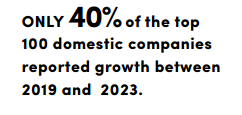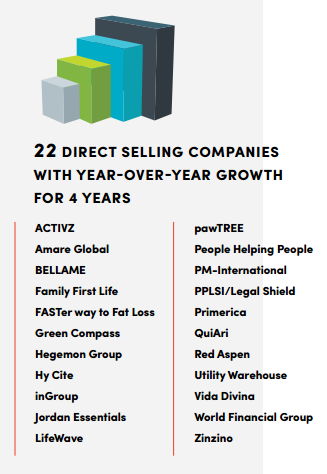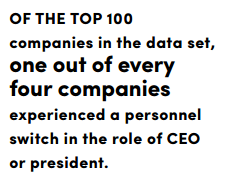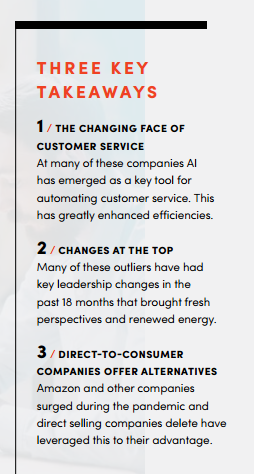Two data-backed studies reveal surprising truths about the industry’s trajectory.
It was tempting to believe that the massive growth observed in 2021 would linger for the industry in the long term. However, what many hoped would become “momentum” proved to be a short-lived spike that tapered off in 2022.
To better understand the significance of this drastic revenue increase and the growth patterns that surround it, Direct Selling News (DSN) analyzed the financial trajectory of the top 100 direct selling companies in North America with at least $50 Million in annual revenue, and three international direct selling companies with at least $50 Million in North American revenue.

These data points, when observed with a wider lens, illustrated two revelations: Only 40 percent of the top 100 domestic companies reported growth between 2019 and 2023; and only 40 percent of those same companies experienced growth in the last year (2022-2023). More than half (60 percent) of the industry experienced decline in 2023, some below 2019 levels.
There continue to be a number of optimistic and bright exceptions within the direct selling industry, but the overall stagnation of the market landscape does not point to a return to pre-COVID levels as many industry leaders had hoped. Instead, these statistics project a ten percent industry decline from 2021 to 2023. In fact, over the last decade, the US direct selling industry has only grown four percent, from a $34.5 Billion industry in 2014 to current projections of $36.5 Billion in 2023.
There is no one silver bullet that can fortify every company, but DSN analyzed the strategies and market fluctuations that positively impacted the resilient companies residing within that positive 40 percent growth trend and considered what leaders can learn from these evolutions as they seek to capitalize on their own potential.
The 40 Percent
DSN has found 22 direct selling companies who maintained year-over-year growth for four consecutive years. These standout companies—including the additional companies within the positive 40 percent growth trend—have been shining examples of how to retain growth amid some of the most tumultuous events in market history, including a global pandemic, a hiring crisis, supply chain upheaval, drastic inflation, international humanitarian emergencies and the ongoing culture challenges that a hybrid and remote work culture presents.

Many of these resilient companies implemented new strategies to stay competitive, like integrating Artificial Intelligence (AI) into their customer service systems and existing digital infrastructures. But customer service is only the tip of the iceberg. Some of the resilient companies on our list are already leveraging machine learning to drive SEO results, streamline workflows and tap into powerful lead generators that speak to the consumer loyalty shift toward social commerce and influencer marketing.

For some within this group, embracing affiliate, omnichannel or hybrid models has been the key to maintaining revenue momentum. Embedding affiliate models within a pre-existing direct selling framework has been an effective way to attract new talent without ostracizing loyal, long-term distributors. For others, combining multiple approaches, often mixing direct selling’s interpersonal sales with the impulse purchasing power of stocking in-store retail shelves, has provided what appears to be a competitive edge.
Changes at the Top
One interesting finding within the data was a pattern of change among the most senior leadership roles. Of the top 100 companies in the data set, one out of every four companies experienced a personnel switch in the role of CEO or president.

These seniority changes occurred primarily in legacy companies, and although there were some leadership changes in younger companies, the data did highlight that the life cycle of a company likely had a constructive impact on healthy growth patterns. Startups and those in their earlier years of business naturally had more exponential growth, given that they are starting from the ground up, even though today’s startups are launching in an era with challenging market dynamics and a heightened regulatory climate.
Many legacy companies sought ways to infuse this startup mentality into their own processes and cultures by streamlining their organizations. These were not choices made from desperation to balance their budgets, but rather strategic and thoughtful moves to become leaner and nimbler as companies seek to grow in the coming months and years.

Opportunity Amid Challenges
Challenges will continue to percolate in 2024, including ongoing litigation from the Federal Trade Commission, unfavorable public perception and the recent passage of the US Department of Labor’s Employee or Independent Contractor Classifications Under the Fair Labor Standards Act, which is expected to create further limitations for millions of entrepreneurs classified as independent contractors, but industry leaders remain optimistic.
Amazon and other mammoth direct-to-consumer market opportunities continue to offer alternate channels for companies and distributors to grow their footprint and brand awareness with customers; the upheaval from post-pandemic office culture is gradually finding level ground; and there are pockets within the direct selling industry that are seeing above average success.
Growth last year was elusive overall, but there are a number of opportunities for the channel to strengthen its positioning and strategies as it seeks to serve and improve the lives of distributors and customers around the world.
From the April 2024 issue of Direct Selling News magazine.

